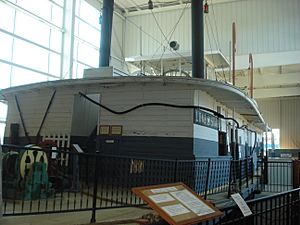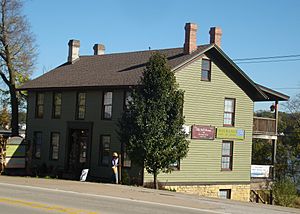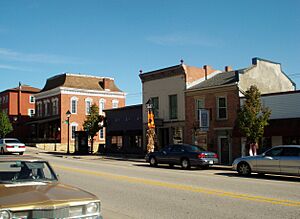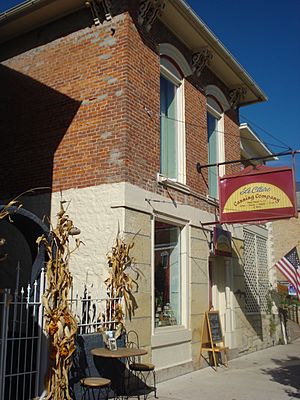Cody Road Historic District facts for kids
Quick facts for kids |
|
|
Cody Road Historic District
|
|
 |
|
| Location | Irregular pattern along Cody Road, Le Claire, Iowa |
|---|---|
| Area | 20 acres (8.1 ha) |
| Built | 1850-1900 |
| Architectural style | Italianate |
| NRHP reference No. | 79000943 |
| Added to NRHP | May 7, 1979 |
The Cody Road Historic District is a special area in Le Claire, Iowa, United States. It's recognized as a historic place across the country. This district includes 60 buildings along a nine-block part of U.S. Route 67, also known as Cody Road. This road is the main street through Le Claire.
The district has two main parts. The south side is where most of the shops and businesses are. The north side is mostly a neighborhood with homes. This historic area was added to the National Register of Historic Places in 1979.
Discovering Cody Road's Past

The first people settled in the Le Claire area in the mid-1830s. By the end of that decade, two towns were planned along the Mississippi River: Parkhurst to the north and Le Claire to the south. A small strip of land between them was called Middletown. In the 1850s, Parkhurst and Middletown became part of Le Claire.
Life in Le Claire depended a lot on the Mississippi River. Le Claire is located at the start of a 15-mile (24 km) rocky part of the river, known as the Upper Rapids. River pilots who knew how to guide steamboats through these rocks were very important. Many of these skilled pilots lived in Le Claire. For example, the home of William Rambo, a river pilot, is in this district.
Other important jobs in the area included stone quarries and brickyards. These businesses used the local limestone and clay. Mills for grinding grain (called gristmills) and cutting wood (called lumber mills) were also a big part of the economy. The homes of John McCaffrey and George Tromley, Sr., who worked in the lumber business, are also found here.
In the early 1850s, Thomas Lancaster and Levi Chamberlin started the Le Claire Marine Railway boatyards. These boatyards and the nearby Old Mill House were bought by J.W. Van Sant in 1862. The boatyards grew to be the town's second-largest employer, after the river itself. J.W.'s son, Samuel, also worked on the river in Le Claire. He later moved to Minnesota and became the state's governor. Samuel's house was at 322 N. Cody Road.
Towards the end of the 1800s, Le Claire's economy started to slow down. The mills closed, and trains began to replace steamboats for travel and moving goods. The forests in northern Minnesota and Wisconsin were used up, which caused the lumber business along the Mississippi to decline.
Even with these changes, small shops continued in Le Claire. The brick commercial buildings you see along Cody Road were built during this time. The town's population dropped from 1,121 people in 1875 to about 700 by 1910.
Le Claire didn't grow much until the 1950s. At that time, the nearby Quad Cities kept growing. This made Le Claire a "bedroom community," meaning people lived there but worked in the larger cities. By the late 1900s, most houses were still lived in and in good shape. However, many commercial buildings were empty and looked old.
Around this time, new shops and cafes started to open in the business area. The city began a $6 million project in 2007 to improve the commercial district. Between 2004 and 2014, 44 new businesses opened. The town's population also grew from 2,868 people in 2000 to almost 4,000.
Buildings and Styles
None of the original factories or large businesses from Le Claire's early days are still standing. What you can see today are homes and shops built between 1850 and 1900, along with some newer buildings.
The commercial buildings from the 1850s and 1860s were mostly made from soft bricks produced right in Le Claire. These buildings are narrow and usually two stories tall at street level. They often have two or three sections on their main front side, called a facade. Their roofs are either broad and low-pitched gable roofs or half-hip roofs. Most building foundations are made from local limestone. Buildings on the east side of the street have basements that can be seen from the outside because the land slopes steeply down to the river there.
The houses in the district were built in a few styles. Some are in the Greek Revival style, which means they have fronts that look the same on both sides and a gable roof. Others are in a local version of the Italianate style. These homes have low hipped roofs and decorative brackets under the roof edges, called cornices. Most houses were built using wood or brick, and only a few used limestone.
Many of the commercial buildings from the later 1800s are brick Italianate structures. They have flat roofs and decorative walls above the roofline, called parapetted fronts. Some of these buildings have metal cornices, which were popular in many Iowa towns back then.
Houses from this later period show styles popular in the late Victorian era. These include Queen Anne, Eastlake, and Shingle styles, as well as more Italianate homes. You can also find a couple of small bungalows and simple, L-shaped houses with front-gable roofs.
The tallest building is the three-story Bard Hotel at 207 N. Cody Road. The old Le Claire city hall, at 201-203 N. Cody, has a special curved hipped roof, window frames with triangular tops (called pedimented window hoods), and a fancy cornice. The former Presbyterian Church, located at 322 N. Cody Road, is the only historic church building in the district. It's a small wooden building with four sections, called bays, and a tower at the front entrance.






